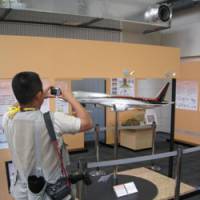RUSUTSU, Hokkaido — Japan's advanced technology may come in handy in the face of the world's growing environmental challenges and the Group of Eight's slow progress on diplomacy.
The technologies put on display for the media at the Rusutsu media center's "environmental showcase" include next-generation electric vehicles with ice-cold motors, affordable fuel cells and a model of what may someday become the world's most energy-efficient regional jet.
The first electric vehicles to be powered by superconducting motors employ technologies used in maglev trains, according to maker Sumitomo Electric Industries Ltd. By cooling both the field coil and armature coil of the motor with liquid nitrogen, electrical resistance is vastly reduced, improving efficiency.
The new Mitsubishi Regional Jet meanwhile makes significant use of tough, lightweight composites in its airframe to reduce fuel consumption 20 percent and noise 50 percent compared with other jets in its class, according to Mitsubishi Aircraft Corp. The 70-90-seat MRJ, whose prototype debuted in March, is expected to enter service in 2013.
Daihatsu Motor Co. displayed platinum-free fuel cells that use cobalt or nickel for electrolytic conversion. It has also succeeded in using hydrazine hydrate, which produces no carbon emissions as a fuel, in batteries instead of hydrogen. Such technologies could help make hydrogen cars affordable, a Daihatsu spokesman said.
Some of the other future technologies aren't necessarily rocket science, however. A new toilet by Toto Ltd. uses pressurized pumps to create a "tornado wash" that saves 65 percent on water use, the Fukuoka-based company said.
The Neorest Hybrid toilet can also learn its owner's toilet-use patterns and adjust seat temperatures to save power — if you're the type of person who uses a plug-in toilet.



